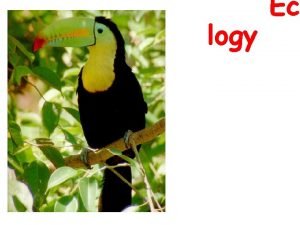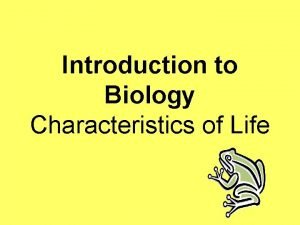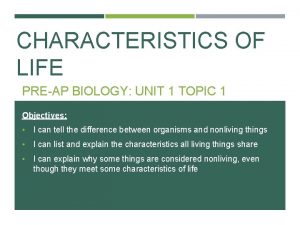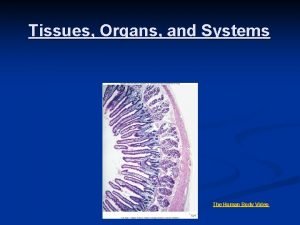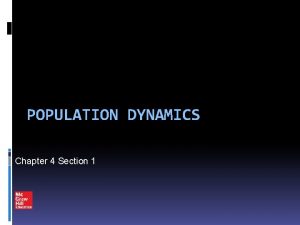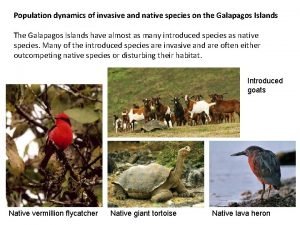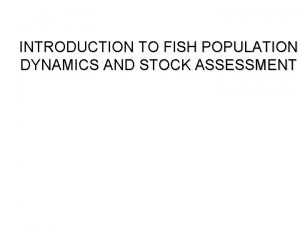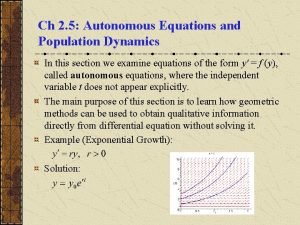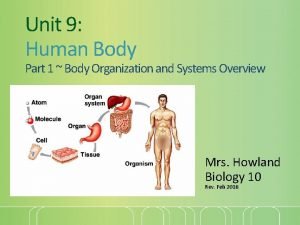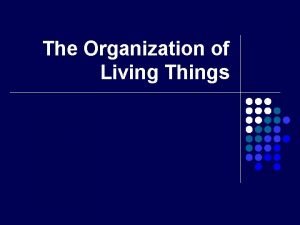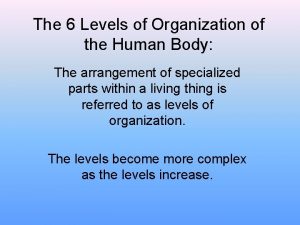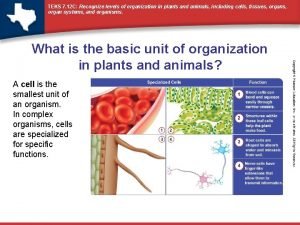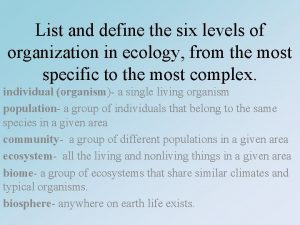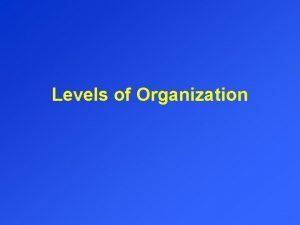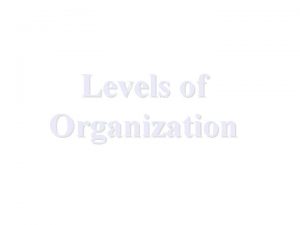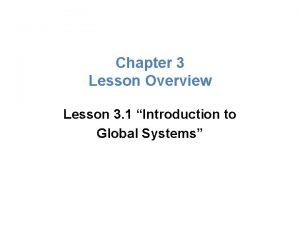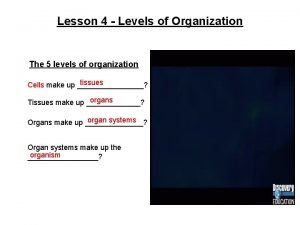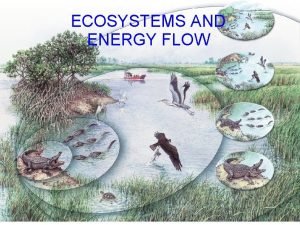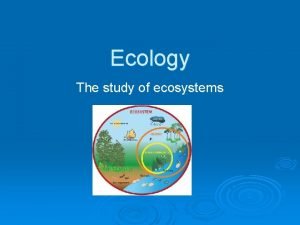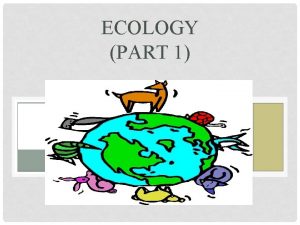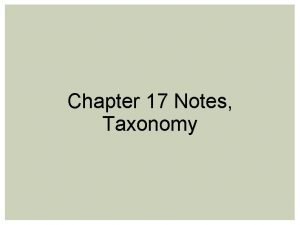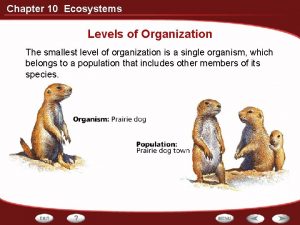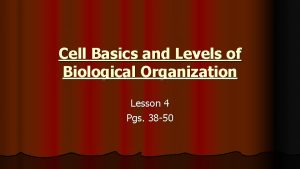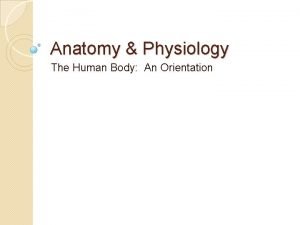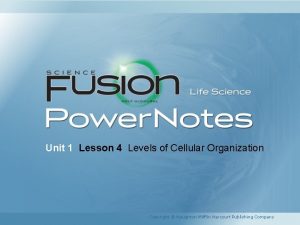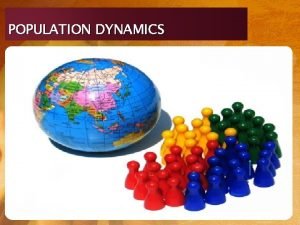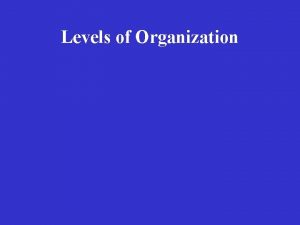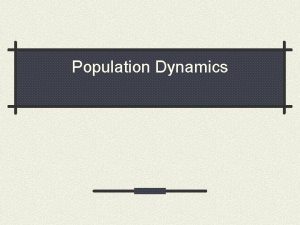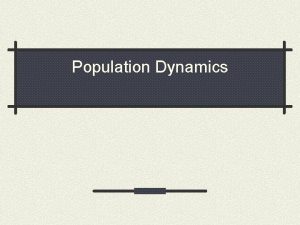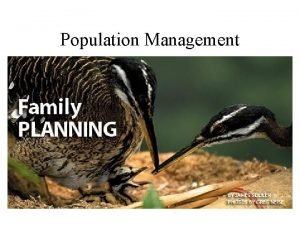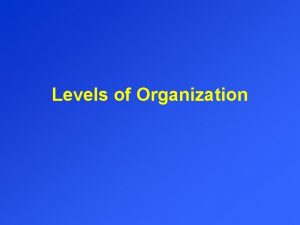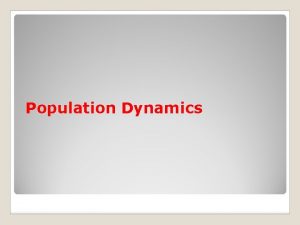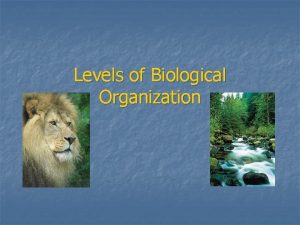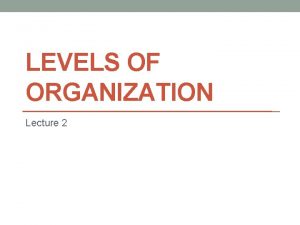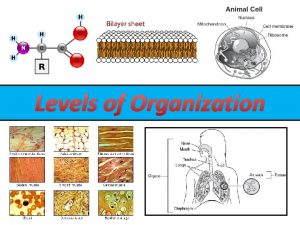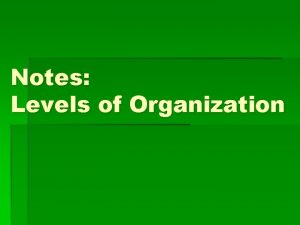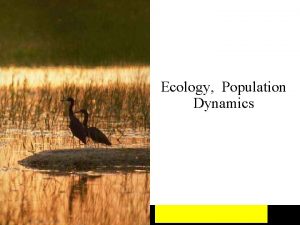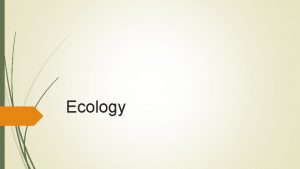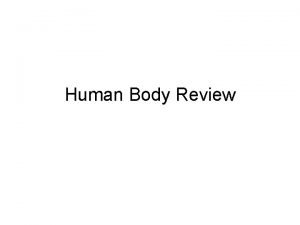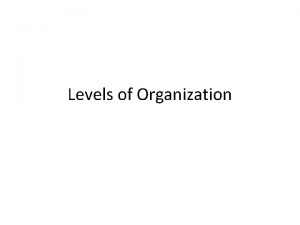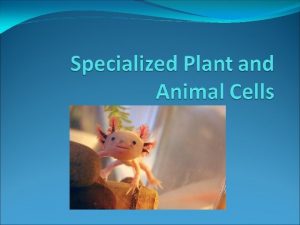POPULATION DYNAMICS LEVELS OF ORGANIZATION one smallest group




































- Slides: 36

POPULATION DYNAMICS

LEVELS OF ORGANIZATION one smallest group individual of organs of living working things all organisms similar different of populations the cells kinds same of group ofunit large living region and with nonliving typical all interacting together organized tissues kind in anliving ecosystem working to in one work together area together things plants interacting and animals within that a certain area includes several ecosystems ion lat pu ics Po nam Dy cell

Population Dynamics How populations change in size due to birth rate/immigration and death rate/emigration and limiting factors ( abiotic and biotic) Birth Rate: Death Rate (number of live birth per 1000) ( number of death per 1000) How does death rate affects population size? Immigration: Emigration: ( movement into (movement out an area) of an area) How does immigration emigration affects population size?

Population Size What goes up must come down • Increases in population: through birth or immigration • Decreases in population: through death or emigration. Change in Population = Birth Rate + Immigration - Death Rate + Emigration

Change in Population = ( Birth rate + Immigration Rate )-( Death Rate + Emigration Rate • What Does a Negative change in population mean? • Birth rate & Immigration rate < Death rate and Emigration rate • Decrease in Population • What Does a Positive change in population mean? • Birth rate and Immigration rate > Death rate and Emigration rate • Increase in population size )

What’s happening to the population? • 500 babies are born • 200 People move to the area = +700 ! ! 400 people. G die! N 100 people move out I W of the area O R = -500 G 700 - 500 = +200 Is the population GROWING or DECREASING?

Logistic or Exponential Growth Curve? Which graph is indicative of natural growth within a population? Can you think of an example of exponential growth? Logistic growth? “Boom and Bust” “Boom then stable”

Exponential Growth (J-shaped Curve) • Rate of growth speeds up at a doubling pace • Y= x 2 • Not realistic in nature indefinitely

Logistic Growth (S-shaped curve) Can you think of some resources that could limit population growth? Characterize these resources as abiotic or biotic? Population size (N) • Populations grow rapidly with ample resources, but as resources become limited, its growth rate slows and levels off Environmental resistance Carrying capacity (K) Biotic potential Exponential growth Time (t)

Logistic Growth Can you think of some resources that could limit population growth? Characterize these resources as abiotic or biotic? Population size (N) • Carrying Capacity (K) is the maximum number of organism that an area can support Environmental resistance Carrying capacity (K) Biotic potential Exponential growth Time (t)

Exponential and Logistic Population Growth: J-Curves and S-Curves • As a population levels off, it often fluctuates slightly above and below the carrying capacity.

Graphing Activity (complete on graphing paper) • Review the Data and Construct a line graph to show the change in Deer Population over time – – Make sure to TITLE your graph Label your X and Y axes appropriately Create an appropriate scale for the population Use 2 different colors for the different populations; include a key YEAR 1975 1980 1985 1990 1995 2000 2005 2010 Tahoma Deer Population size 300 450 650 750 825 850 825 Mt. Helen Deer Population Size 200 350 500 750 900 725 700

Exit Ticket-Analyze Data Answer the following questions on the same paper as your graph. 1. During which years did the deer populations grow exponentially? Write the Questions and Answers 3. What is the Carrying Capacity for the Tahoma Deer population? 2. During which years did the deer populations reach carrying capacity? 4. What is the Carrying Capacity (K) for the Mt. Helen Deer population? 5. Which population grew the fastest?

Limiting factors FACTORS THAT AFFECT POPULATION DYNAMICS

Limiting Factors • **A limiting factor (or limiting resource) is a factor that controls a process, such as organism growth or species population, size, or distribution – Abiotic Limiting Population Factors (LPF) • Availability of space • Natural Disasters • Availability of water – Biotic Limiting Population Factors (LPF) • Predation • Competition

Density ***How compact, or crowded an area is • **Population Density: – How many species occupying an area • Population/unit area • Density Independent Factors VS. Density Dependent Factors – Think what the difference is between Independent and dependent

Density Dependent Factor • limits the population depending on the amount of organisms in a given area (Density!) – Predation – Competition – Human Activity – Disease

Think about this… How many people live in your house? What would happen is some one caught a contagious flu virus in your home? Is it a good idea to invite lots of people over your house is some one in your house is very sick with a contagious flu? Why or why not? http: //www. learner. org/courses/envsci/interactives/disease/

Density Independent Factor • Does NOT matter how dense a population is • Affects population size regardless of density – Seasonal Variations – Natural Disasters – Catastrophic Events

Think about this…. Tropical Plants like warm weather. If it ever snowed In tropical regions, most likely ALL those plants would die, because it is just too cold for them to live If there were 100 tropical plants where it snowed, what percent would die? If there were 20 tropical plants where it snowed, what percent would die?

Does not matter how many people in an area AKA- INDEPENDENT from DENSITY Same Percent will still be affected

Human Population Growth

Question #1 • A population of rabbits experience a decline in population due to a parasitic bacteria that spread disease among the population, killing many of the rabbits. – What is the limiting factor? Is it Density Independent or Density Dependent? (2 points)

Question #2 • A fire swept across the everglades. Many trees were destroyed that were home to several species of birds. As a result, the bird populations experienced a large decline. • Was the factor limiting bird population in this example density dependent or independent? What is the limiting factor for the bird population? (2 points)

Question #3 • A significant amount of a toxic chemical was dumped into a small lake that served as a habitat for a population of catfish. As a result, the catfish in the lake became sick and died. • Is the chemical a density independent or density dependent factor? (1 point)

Question #4 • A foreign species of carnivorous fish was recently introduced into the bay area in Key Biscayne. • What will most likely happen to the population of native fish in the area? • (1 point)

Human population Human Population Growth Information-globalization revolution Agricultural revolution Industrial-medical revolution 275 yrs ago 50 yrs ago Present 12, 500 yrs ago Time (not to scale) Fig. 1 -16, p. 19

Human Population Growth Rate Has Changed Throughout History • Change has been a dramatic increase over time – Up until recently, only half of children born survived into adulthood – Death rates were high due to disease, famine – Population growth rate was slow • NOW: Advances in medicine, technology, and communication have increased human growth rate exponentially

Get thinkin’ • How could have advances in medical innovations affected population rate? • How could have advances in technology and communication affect population rate?

How Do We Study Human Populations? • Demography: The scientific study of human populations – Tries to explain how populations change over time • Growth rates predicted based on: – Birth rates – Death rates – Age structure • Compares the distribution of age groups in a population

Rapid Growth Slow Growth No Growth

Age Structure Younger, • Age structure predicts population growth – Rapid growth • More young people than older people – Slow Growth • About even number of age groups – No Growth • More older people than young people juvenile ages more likely to reproduce than elderly people

Controversy with growing population • The more people populating earth, the faster resources diminish (density dependent factor) • Laws can be made to help slow this exponential growth state – China- only one child born per family un urban areas – Increase status of women – Increase education

Knowledge check 1. The number of individuals of a single species per unit are is known as: A. B. C. D. Carrying capacity Logistic growth Population density Population growth

Knowledge Check 2. One example of a density-independent limiting factor is A. Predation B. Hurricanes C. Competition D. Parasitism

Knowledge Check 3. The scientific study of human population growth is known as A. Immigration B. Emigration C. Demographic transition D. Demography
 Section 1 population dynamics answer key
Section 1 population dynamics answer key Population ecology section 1 population dynamics
Population ecology section 1 population dynamics Population ecology section 1 population dynamics
Population ecology section 1 population dynamics Chapter 4 population ecology answer key
Chapter 4 population ecology answer key Levels of organization from smallest to largest
Levels of organization from smallest to largest Levels of biological organization from smallest to largest
Levels of biological organization from smallest to largest Levels of ecological organization from smallest to largest
Levels of ecological organization from smallest to largest Rough er function
Rough er function Biological organization from smallest to largest
Biological organization from smallest to largest Smallest to largest level of organization
Smallest to largest level of organization Chapter 4 section 1 population dynamics
Chapter 4 section 1 population dynamics Section 1 population dynamics answer key
Section 1 population dynamics answer key Population dynamics
Population dynamics Fish population dynamics and stock assessment
Fish population dynamics and stock assessment Autonomous equations and population dynamics
Autonomous equations and population dynamics Costas questions
Costas questions Unit 9 human body systems review
Unit 9 human body systems review Organization of living things
Organization of living things 6 levels of organization
6 levels of organization Plant organization levels
Plant organization levels Biological organization levels
Biological organization levels In what ways are herbivores and carnivores alike
In what ways are herbivores and carnivores alike What is the smallest part of a plant
What is the smallest part of a plant Levels of organization in an ecosystem
Levels of organization in an ecosystem Chapter 3 lesson 1 introduction to global systems
Chapter 3 lesson 1 introduction to global systems 5 levels of organization
5 levels of organization 5 levels of organisms
5 levels of organisms Levels of organization in ecosystem
Levels of organization in ecosystem Levels of organization ecosystem
Levels of organization ecosystem Levels of organization in the biosphere
Levels of organization in the biosphere Levels of organization biology
Levels of organization biology Levels of organization in the biosphere
Levels of organization in the biosphere Taxonomic levels of organization
Taxonomic levels of organization Levels of organization ecosystem
Levels of organization ecosystem Cell theory and levels of organization warm up
Cell theory and levels of organization warm up Levels of structural organization
Levels of structural organization Lesson 4 levels of development
Lesson 4 levels of development




